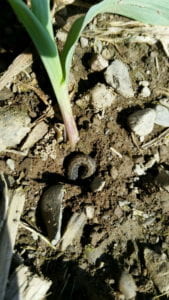
This spring throughout the Northeast we are seeing areas with increased catches of Black Cutworm moths in pheromone traps. Delaware County is one of these areas with elevated Black Cutworm moth catches, and we are starting to hear reports of cutworm damage in the county. While Integrated Pest Management specialists are quick to point out that elevated catches do not necessarily mean damage will be greater, it does signify that the risk of cutworm damage may be greater.
Black Cutworm moths travel in from other parts of the US on storm fronts, as do many other crop pests. The moths typically (although not always) look to lay their eggs in areas where there is some green growth, such as weedy fields. Black Cutworms are nocturnal and feed on corn plants at night. During the day they hide in the soil at the base of corn plants. Delayed crop planting this year, puts the seedling corn at greater risk as economic damage thresholds are more quickly achieved on smaller corn plants:
What to D0:
- Scout your Corn:Now is the time to get out in corn fields and look for cutworm damage. Cutworm damage is easy to spot; look for corn plants cut off as the soil level. Sometimes (especially in dry conditions) the larvae will cut the palnt below the soil surface and the corn seedling will simply wilt and die in place. Depending on when plants were cut, there may or may not be a corn plant yet on the soil surface. Where there is evidence of freshly cut plants, dig into the soil within a couple inch radius of the corn plant. Typically, the cutworm (a black greasy looking caterpillar) can be found readily (see photo). It should be noted that cutworm damage can look a lot like bird damage where birds snip of the corn plant in the process of trying to pull it up. The defining variable will be the finding of the cutworm larvae.
- Act if Necessary: Just because you find cutworm damage and live cutworms does NOT mean that you have the pest at a level that will cause economic damage. Integrated pest management specialists have determined the following economic damage thresholds, when reached or exceeded, would warrant chemical control;
- Corn at V2 stage (2 fully emerged leaves with leaf collars) – 2 cut plants per 100
- Corn at V3 stage (3 fully emerged leaves with leaf collars) – 3 cut plants per 100
- Corn at V4 stage (4 fully emerged leaves with leaf collars) – 5 cut plants per 100
- Corn at V5 stage (5 fully emerged leaves with leaf collars) – 7 cut plants per 100
NOTE: Be realistic about how extensive the damage is in the field – it may only be in an isolated area
NOTE: If larvae are large (1.25″) they will pupate soon and most of the damage is already done.
If you find you have economic damage and larvae still have growth left (and damage left to do), chemical control is an option, and can be combined with herbicide applications that may still need to be done.


